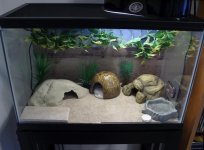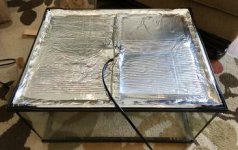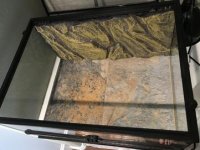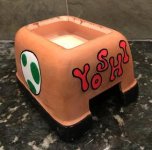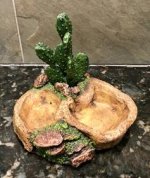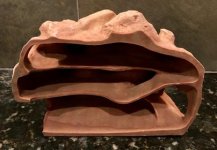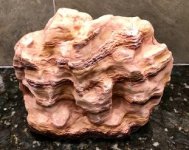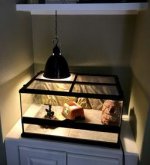Well, your pic is kinda little and it's hard to tell what's going on, but…
Regarding hides…
Warm hide - IMHO, should be just an enclosure with NO floor at all, especially if you are using a ceramic tile floor with a UTH. Why? Your gecko is going to want to lay in the warm hide directly on the ceramic tile, warming his belly to aid his digestion. It should also be the biggest hide since the heat needs to ventilate somewhat, and your gecko (normally) will spend most of his time here. This should be his coziest hide.
Moist hide - you need a moist hide in the center, keeping the cool and warm to the opposite far sides, making the most of the temp gradient. Keeping the moist hide in the center will keep it from being too warm or too cool. It will get the best of both worlds there, and give your gecko an in-between temp to relax. Cold moisture is NOT good for your gecko. You will have to check the moist hide daily though, if it's anywhere overlapping the heat mat (which is okay), to keep it from drying out. Your gecko NEEDS the moist hide to help him shed easier. I’d use your terra-cotta hide as the moist hide. You can keep the water on top of it, but I’d put a layer of crumbled wet paper towels underneath inside…and moisten it every day….changing it once a week.
Cool hide - I’d use your multi-level hide for this one. Put it against the side furthest from the heat mat. Your gecko will be just as concerned over privacy as he will having light beaming on him. I'd put that thing against one of the side walls, where you can kinda see it somewhat, but he feels secure enough not be exposed to everything coming up to the tank freaking him out.
Your light - honestly, this is the one mistake most gecko owners buy. You don’t really need it at all. Geckos HATE light. They are crepuscular and only come out in the wild at dawn and dusk because they HATE sunshine. It hurts their eyes. If you have a light in that room, or say you leave a window slightly open to let light in…your gecko just needs light for biological clock reasons. He needs to be aware of day and night. You could have a desk light set on a timer in his room, that comes on for 12 hours and goes off. Or you can do what I do…buy a really dim 25 watt bulb and a dimmer switch…hook it up to a timer, and keep it over his tank, not for heat purposes, but just so he gets his 12-14 hours of light each day (my gecko is in a room with no daylight coming into it). Geckos aren’t like snakes or bearded dragons where they have very regimented UV light requirements. They’re not basking reptiles at all (although some geckos do sit under red or moon bulbs). I have a double dome light…one socket is my 25 watt bulb, the other socket is a ceramic heater bulb (it’s not a light) - this one comes on at night, and it’s strictly there to make sure his cool side doesn’t get too cool. I have dimmer switches on both of these (you can buy them at Lowes). I keep this double dome setup over his cool side, and I have it setup so the temps on the cool side go no higher than 78°. Lastly, NEVER let direct sunlight hit his tank.
Water dish - get it as far away from the heat mat area as possible. Why? Because if your gecko gets sloppy in his water dish (and he will), if he splashes water out and it seeps under the tiles and hits hot glass it will crack the bottom of your tank. Plus, you don't want a water dish near the heat pad because it will dry out quicker (and who likes warm water...yuck). For your combination bowl, I'd put water in the bigger side and pure calcium powder (no D3) in the other. Don’t put bugs in these dishes. In fact, don’t EVER leave ANY bugs in his tank. Drop one in at a time. If he doesn’t eat it, remove it…he’s telling you he’s not hungry. Try again the next day. Or maybe he just doesn’t like the type of bug you’re feeding him (geckos can be very articular about their food). Try another type of bug. But don’t leave bugs in his tank, thinking he’ll eat it later…chances are he won’t and the bug running around him will stress him out…he’ll stay in his hide and won’t eat.
My gecko uses all three hides throughout the day. His warm side floor temp is at 88-92°, and the cool side floor is around 75-78°. Here's a pic of my small 10 gallon tank...(l to r): warm, moist, cool.
